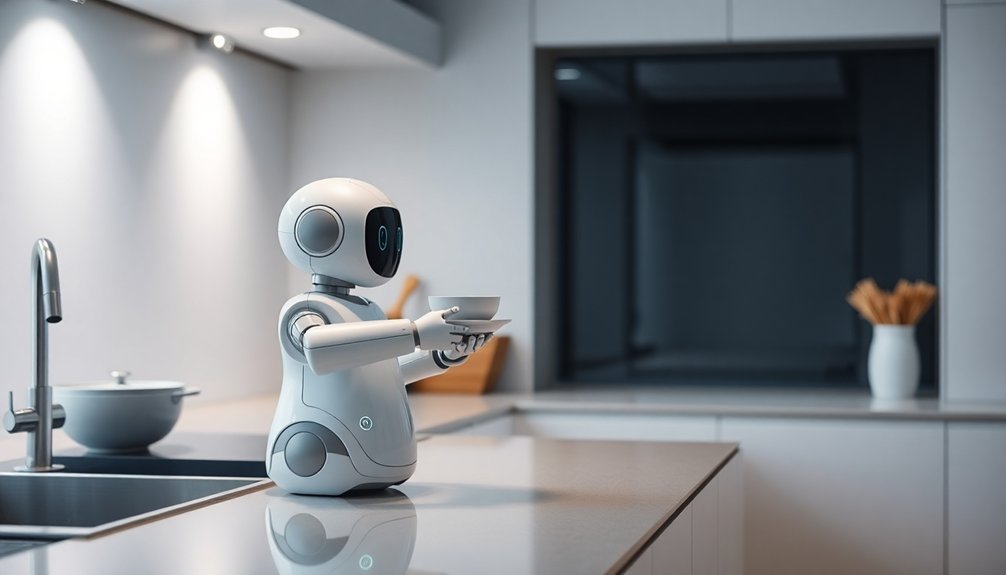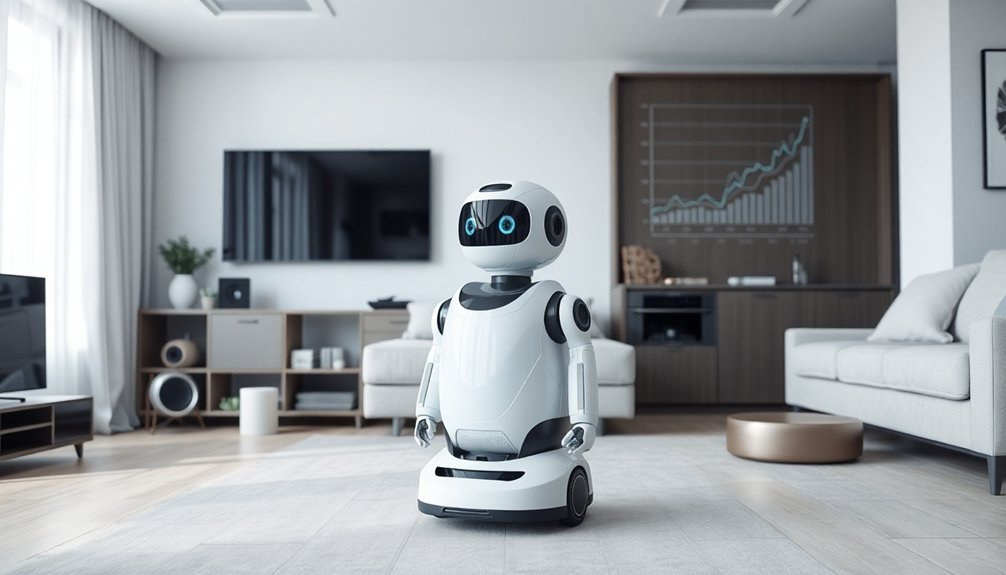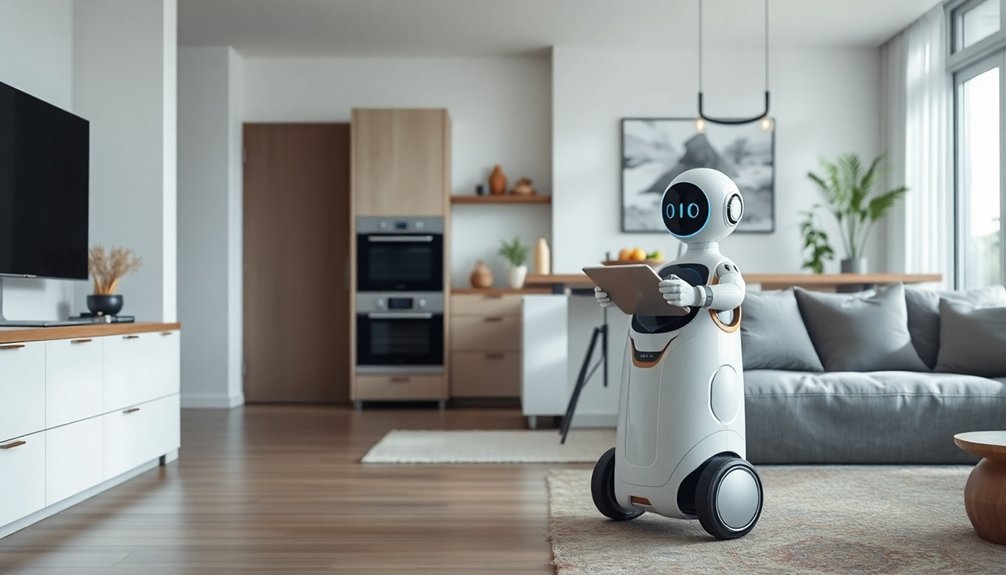Table of Contents
Home robots are totally your next tech obsession. Imagine a gadget that cleans, manages your schedule, and maybe even keeps grandpa safe—without the drama of a needy smartphone. They’re not just cool; they’re becoming essential. With AI getting smarter and prices dropping, these little mechanical buddies are transforming from weird sci-fi dreams into must-have home companions. Curious how they’ll flip your daily routine upside down? Stick around.
The Rise of Household Robotics

While robots used to be the stuff of sci-fi fantasies, household robotics have quietly invaded our homes like digital house guests who actually do chores. Household Robot Market Value is set to skyrocket from $10.15 Billion in 2023 to a staggering $48.85 Billion by 2032.
From vacuuming your floors to mowing your lawn, these mechanical helpers are turning lazy Sundays into productivity parties. The market’s booming – we’re talking billions of dollars and crazy growth rates that would make Silicon Valley geeks dizzy. Major Tech Investments are driving robotic innovation across multiple sectors, with companies pouring significant resources into research and development. Collaborative robotics are transforming how humans interact with technology in home environments.
Think robotic vacuum cleaners aren’t sexy? They’re just the beginning. Imagine AI-powered companions cleaning windows, scrubbing pools, and maybe even offering a witty comment while they work.
North America’s already leading the charge, with Asia Pacific hot on its heels.
Sure, privacy concerns and high prices might make you hesitate. But as technology gets smarter and cheaper, these robots are less sci-fi and more everyday reality.
Technology Driving Consumer Adoption
The sci-fi dream of robotic household helpers isn’t just fantasy anymore—it’s getting real, thanks to some mind-blowing tech advances. AI-powered innovations are driving a 25.04% market growth in consumer robotics, transforming the industry from niche technology to mainstream convenience. Robotic market expansion is accelerating as manufacturers like iRobot demonstrate continuous technological innovation.
Imagine robots that actually understand your home’s layout, dodge furniture like ninja warriors, and learn your cleaning preferences. Robot Operating Systems and AI are transforming clunky machines into smart assistants that can navigate your space with precision.
Advanced sensors like LIDAR aren’t just sci-fi mumbo-jumbo; they’re making robots see your world in 3D. Want proof? Look at how machine learning is turning robots from awkward automatons into intuitive helpers that can adapt to your lifestyle.
Young tech enthusiasts are especially pumped, seeing household robots as the next cool gadget that’ll make daily chores feel like a breeze.
The future? It’s looking seriously robotic.
Market Growth and Economic Potential

Imagine a world where your bank account actually wants you to buy robots. With projections hitting a mind-blowing $48.85 billion by 2032, these aren’t just gadgets—they’re economic game-changers. Global market trends suggest North America is leading this robotic revolution, with strong smart home adoption and significant AI implementation driving consumer interest. Home Robot Market Dynamics reveal that the industry is experiencing a robust 25% compound annual growth rate, indicating massive potential for technological and economic expansion. Humanoid robot technologies are specifically driving unprecedented innovation in this rapidly evolving market.
Rising disposable incomes mean you’ll soon see robots doing everything from mopping floors to mowing lawns. Companies like iRobot and Samsung are betting big, turning household chores into high-tech adventures.
Sure, the price tag might make you wince right now, but competition’s driving costs down. AI and battery tech are working overtime to make robots smarter and cheaper.
Who wouldn’t want a personal assistant that doesn’t complain about overtime?
Innovations Transforming Everyday Life
Ever wonder how robots are about to turn your mundane household routine into a sci-fi movie? Envision this: a robot emptying your dishwasher while another vacuums those mysterious crumbs under the couch.
These aren’t just fancy gadgets—they’re transforming how we live. Smart cleaning robots like Roomba are now tackling dusting and mopping with ninja-like precision.
Robotic revolutionaries are here: cleaning smarter, faster, and with superhuman precision.
Meanwhile, AI-powered assistants are becoming your personal home managers, tracking everything from medication schedules to potential fall risks for elderly family members. The Hyodol robot, for instance, provides elderly companion monitoring by assisting seniors with health check-ins and offering companionship. They’re not replacing humans; they’re becoming collaborative partners.
Imagine robots that learn your preferences, anticipate your needs, and make life smoother. Mechanical design innovations are enabling robots to mimic human movements with increasing precision and adaptability. The future isn’t about replacing human connection—it’s about creating smarter, more efficient living spaces that give you back precious time. With advancements in humanoid robot technology, companies like Tesla and Boston Dynamics are developing robots that can perform complex household tasks with increasing sophistication.
Future Landscape of Home Automation

As smart home technologies evolve at lightning speed, you’re about to witness a radical transformation in how we interact with our living spaces. With projected market revenue reaching US$250.6bn by 2029, home automation is set to become a ubiquitous ecosystem of intelligent connectivity. The home automation market is projected to grow significantly, with North American market leading global adoption and driving technological innovation. Neuromorphic computing platforms will enable home robots to adapt more intuitively to individual household environments and user preferences.
Imagine AI-driven systems that anticipate your needs before you even think of them—voice assistants that aren’t just listening, but understanding; security networks smarter than most human guards; heating systems that know exactly when you’re chilly.
The future isn’t just connected—it’s predictive. With 5G networks and machine learning, your home will become a responsive ecosystem.
Edge computing means faster, more localized decisions. Blockchain might secure your data. And those voice-controlled hubs? They’re just the beginning of a revolution that’ll make today’s smart homes look like ancient technology.
Want in? The smart money’s already betting big.
People Also Ask
Can Home Robots Actually Learn and Adapt to My Specific Household Needs?
You’ll find home robots can learn and adapt through advanced sensors, AI, and continuous interaction, allowing them to understand your unique household routines and customize their performance over time.
Are Home Robots Safe Around Children and Pets?
You’ll be shocked! Modern home robots are designed with mind-blowing safety features like collision detection and gentle interactions. They’re carefully programmed to avoid hazards, making them surprisingly safe companions for children and pets when used responsibly.
How Expensive Are Home Robots Compared to Traditional Household Appliances?
You’ll find home robots are typically pricier than traditional appliances, with basic models starting around $1,000–$5,000, while robotic vacuums are more affordable at $200–$1,500, compared to household items like refrigerators and washing machines.
Do Home Robots Require Constant Technical Maintenance or Complex Setup?
You’ll find home robots surprisingly easy to set up and maintain. They don’t need constant technical attention, with most requiring only annual maintenance. Their user-friendly design means you can quickly integrate them into your home without extensive technical expertise.
Will Home Robots Eventually Replace Human Workers in Domestic Tasks?
Could robots revolutionize your home life? You’ll likely see partial job displacement, but not total replacement. Robots will handle repetitive tasks, while humans remain essential for complex, interpersonal domestic work requiring emotional intelligence and nuanced care.
The Bottom Line
While robots might seem like sci-fi fantasy today, they’re quietly becoming your next household companion. Just as smartphones transformed communication, home robots will redefine domestic life—turning mundane tasks into automated symphonies. The line between human convenience and technological intimacy blurs, promising a future where your robotic assistant knows you better than you know yourself. Are you ready for this seamless, silicon-powered revolution?
References
- https://www.globenewswire.com/news-release/2025/05/05/3073803/0/en/Household-Robots-Market-to-Surpass-USD-48-85-billion-by-2032-growing-at-a-CAGR-of-19-10-SNS-Insider.html
- https://www.globenewswire.com/news-release/2025/04/01/3053510/0/en/Household-Robots-Market-is-expected-to-generate-a-revenue-of-USD-42-63-Billion-by-2031-Globally-at-24-9-CAGR-Verified-Market-Research.html
- https://www.statista.com/outlook/tmo/robotics/service-robotics/consumer-service-robotics/domestic-service-robotics/worldwide
- https://www.cognitivemarketresearch.com/home-robot-market-report
- https://www.researchandmarkets.com/reports/5790505/household-robots-market-report
- https://www.mordorintelligence.com/industry-reports/household-robots-market
- https://straitsresearch.com/report/household-robots-market
- https://www.datainsightsmarket.com/reports/household-robots-market-14866
- https://www.precedenceresearch.com/consumer-robotics-market
- https://business.yougov.com/content/51596-two-in-five-americans-are-interested-in-having-a-household-robot-take-care-of-their-chores
